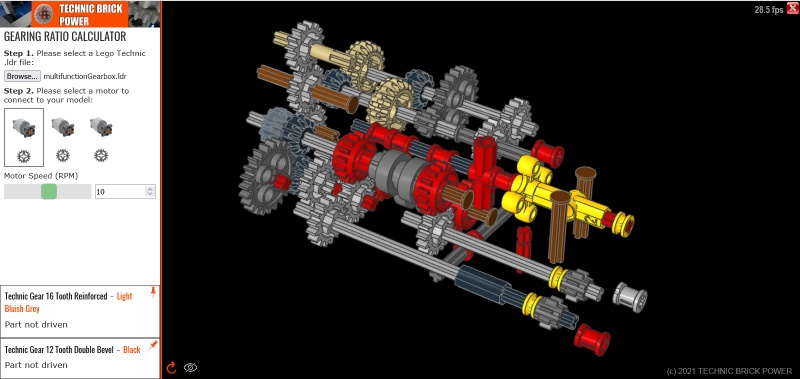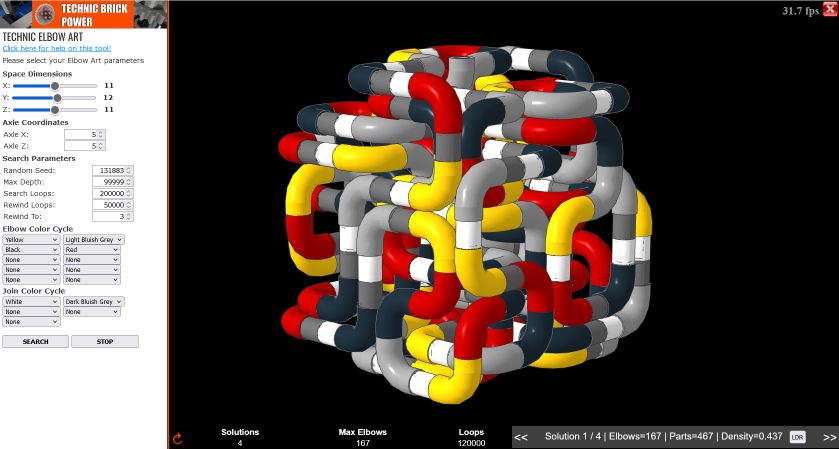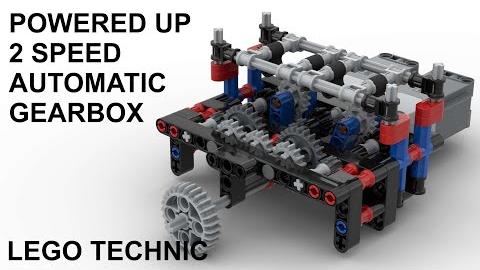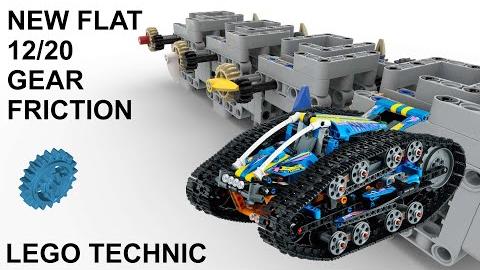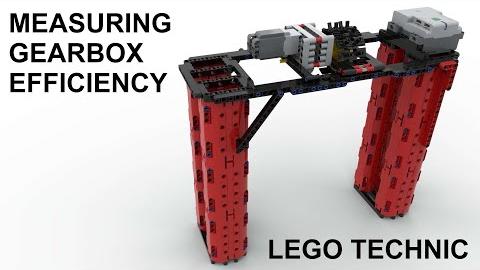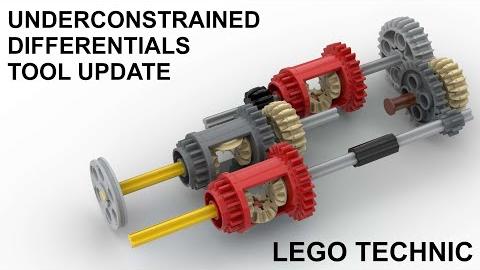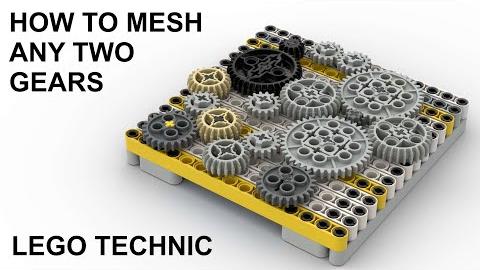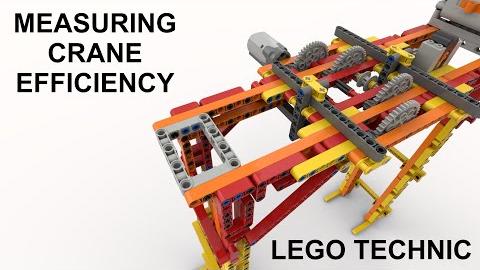How do you make a 1:N gearing ratio?
So you need to make a 1:N gearing ratio for your project where N is some whole number like 21, 40, or even 100? In general this can be easy or difficult depending on your number N. One general solution is to create a gear chain using n gearing ratios of 1:M0, 1:M1, 1:M2,... ,1:Mn. such that M0 x M1 x ... x Mn = N then the overall gear chain ratio will be 1:N. So that means you need to break down your number N into a number of factors that can be created by a pair of Lego gears. For example if N is 36 then you can write
36 = 3 x 3 x 2 x 2
So then you create a 1:36 gear ratio by creating a gear chain of simpler gears using 1:3, 1:3, 1:2 and 1:2. Now of course since the order of multiplication doesn't matter you can put these in any order, e.g. you could also use 1:2, 1:3, 1:3 and 1:2. So below is an example solution for a 1:36 gearing ratio using the first order shown.
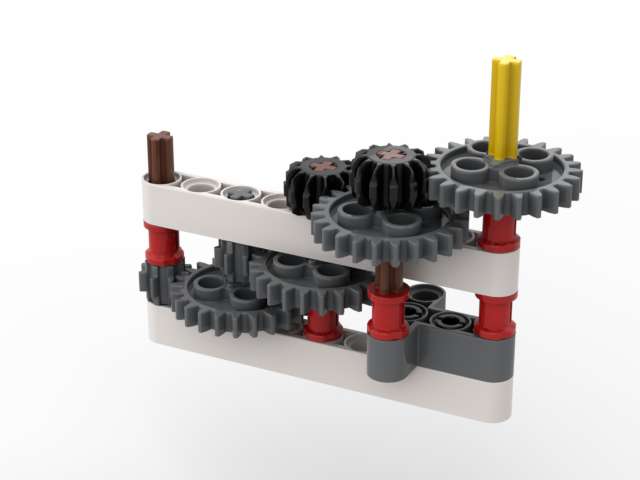
Here the gearing ratio between the brown input axle and yellow output axle is 1:36.
Now due to the limited number of gears available in Lego Technic, it is only possible to create the gearings ratios of 1:2, 1:3, 1:5 and 1:7 directly using just two gears (i.e. without differentials) so that means your number N must be a product of one or more of the numbers 2, 3, 5 and 7 for this method shown here to work. For example below are the possible 1:N gearing ratios up to N <= 50 using this method:
| N | Factors |
| 2 | 2 |
| 3 | 3 |
| 4 | 2 x 2 |
| 5 | 5 |
| 6 | 2 x 3 |
| 7 | 7 |
| 8 | 2 x 2 x 2 x 2 |
| 9 | 3 x 3 |
| 10 | 2 x 5 |
| 12 | 2 x 3 x 3 |
| 14 | 2 x 7 |
| 15 | 3 x 5 |
| 16 | 2 x 2 x 2 x 2 |
| 18 | 2 x 3 x 3 |
| 20 | 2 x 2 x 5 |
| 21 | 3 x 7 |
| 24 | 2 x 2 x 2 x 3 |
| 25 | 5 x 5 |
| 27 | 3 x 3 x 3 |
| 28 | 2 x 2 x 7 |
| 30 | 2 x 3 x 5 |
| 32 | 2 x 2 x 2 x 2 x 2 |
| 35 | 5 x 7 |
| 36 | 2 x 2 x 3 x 3 |
| 40 | 2 x 2 x 2 x 5 |
| 42 | 2 x 3 x 7 |
| 45 | 3 x 3 x 5 |
| 48 | 2 x 2 x 2 x 2 x 3 |
| 49 | 7 x 7 |
| 50 | 2 x 5 x 5 |
Now of course you are not limited to just 1:M gearing ratios in the product, especially since 1:7 can only be made with an 8 tooth gear driving a 56 tooth turntable and so it is more convenient to use a 20 to 28 which gives 4:7 and you then need to cancel out the 4 by placing it in the denominator.
In summary, to create your 1:N gearing ratio, just look up your number in the table above and use the required factors (you will have to work them out for yourself for N > 50) in a gear chain.
Now what if you need to create a gearing ratio of 1:N where N cannot be created as a product of 2, 3 ,5 and 7 (e.g. 13, 17, 71 or other primes)? The answer is to use a differential! (see the section of differentials for more details when that becomes available...).
More to explore
Lego Technic PU 2 Speed Automatic Gearbox
This video presents a lego technic two speed automatic gearbox using two motors and the Powered Up (PU) lego technic control system. Each motor uses a pivoting gear to either connect to it's gear to the left when rotating in the forward direction or to the gear to the right when reversing. Th...read more
New Flat 12/20 Gear Friction
The Lego Technic set 42140 App-Controlled Transformation Vehicle introduces two new gears - a flat version of the 12 tooth bevel gear and a flat version of the 20 tooth bevel gear. These gears are designed to have less friction.
In this video I measure the difference in gearing efficiency...read more
Gearing Ratio Calculator Tool Help
Measuring Gearbox Efficiency
This video describes a method for measuring the efficiency of a gearbox using the Lego Technic Powered Up hub. Gearbox efficiency is defined as the ratio of the output power to the input power and here I show how to measure each of these values to allow you to calculate the overall efficiency.read more
How do you make a 1:5 gearing ratio?
Lego Technic Gearing Ratio Tool Update
This video presents updates to the Technic Brick Power Lego Technic Gearing Ratio Calculator tool specifically on underconstrained differential systems. These are systems in which the differentials are not fully constrained and therefore have 1 or more degrees of freedom within them.
The ...read more
What is a gearing ratio?
Lego Technic Gearing Ratio Calculator Tool
Here I present my new Lego Technic Gearing Ratio Calculator tool. This tool allows you to upload your Lego Technic .ldr (Lego Draw) file and it will simulate the gearing system and visualize it as well as showing the gearing ratios relative to the input component.
The tool can be accessed...read more
How to mesh any two Lego gears on a regular grid!
In this video I analyze all of the eight regular lego technic gears and demonstrate how any two of them can be meshed on a lego grid.
A sum of radii chart is used to determine the possible diagonal meshing combinations. These are then combined with "intermediate" or "idler&...read more
How to measure a Lego Technic Crane's Efficiency. The results surprised me!
Here I demonstrate how to measure the efficiency of a Lego Technic MOC crane using basic physics. Efficiency is the ratio of the useful energy output (the potential energy put added to the weight) the to the input energy (power source power). The efficiency curve is interesting and does not look ...read more
